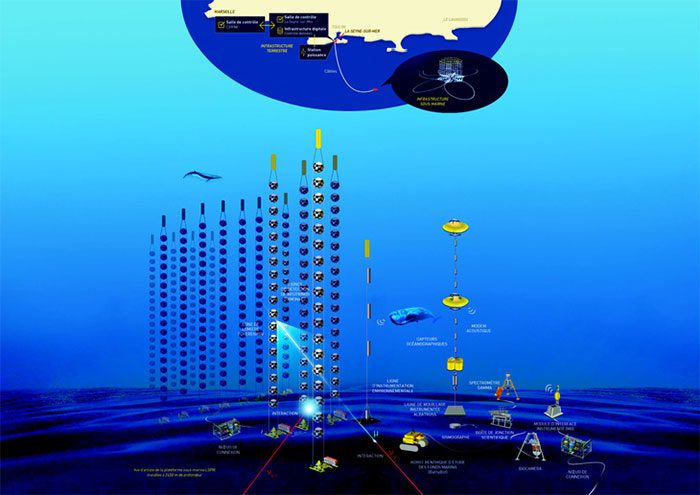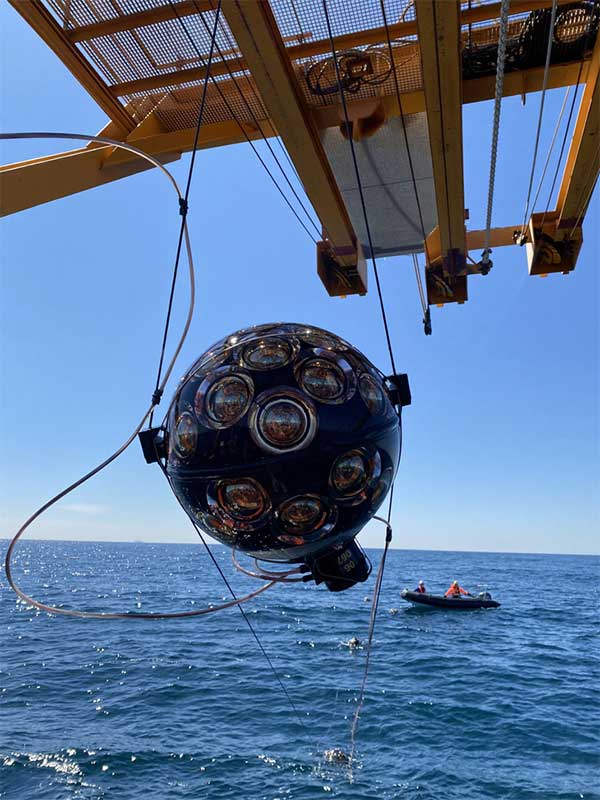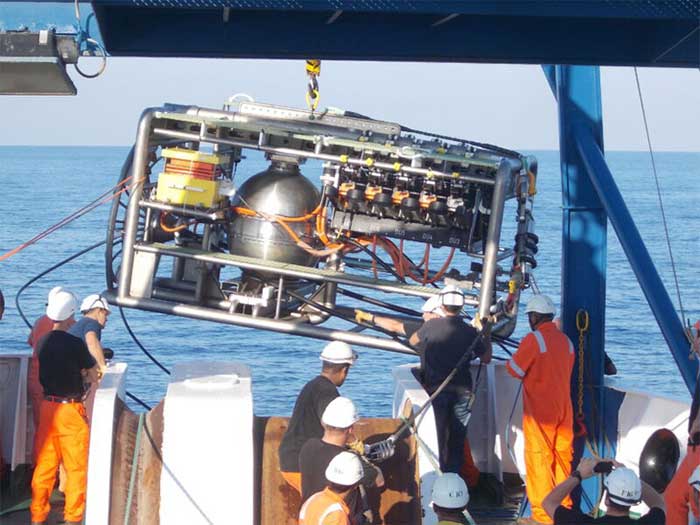The Laboratoire Sous-marin Provence Méditerranée (LSPM) is located 40km off the coast of Toulon, France, at a depth of 2,500m.
This is the first remotely operated underwater laboratory in Europe. LSPM is managed by the French National Centre for Scientific Research (CNRS) in collaboration with Aix-Marseille University (AMU) and the French Institute for Marine Research (IFREMER).

Illustration of the LSPM underwater laboratory – (Photo: AGENCE OUVERTBOIRE).
Exploring the Universe from Underwater Laboratory
Currently, the LSPM center consists of three junction boxes capable of powering several devices and retrieving data.
Each box measures 6m in length and 2m in height, connected to the land-based electrical system via a 42km long fiber optic cable. The optical part of this cable is used to collect data from the junction boxes.
Of these, two junction boxes are dedicated to the ORCA component of the Kilometer Cube Neutrino Telescope (KM3NeT).

Optical detection module of the Kilometer Cube Neutrino Telescope (KM3NeT) – Photo: CNRS
ORCA consists of a three-dimensional array of 2,070 spheres, each containing 31 detectors known as photomultiplier tubes. These spheres will be arranged on 115 moorings at the ocean floor and kept taut by submerged buoys. Currently, 15 moorings have been installed.
The twin facility of ORCA is ARCA, located off the coast of Sicily, Italy, at a depth of 3,400m.
“These giant arrays of detectors can detect subatomic neutrinos emitted from the universe. These fundamental particles originate from outside Earth and can pass through our planet without colliding with any atom.
In the rare instances when neutrinos interact with water molecules, they produce a faint blue light in the darkness of the ocean depths. Detecting this light allows us to measure the direction and energy of the neutrinos,” said Paschal Coyle, research director at the Centre de Physique des Particules de Marseille and director of LSPM, in an interview with Ars Technica.

Workers deploying junction box number 1 of the LSPM center – Photo: ARS TECHNICA
The third junction box is dedicated to marine scientific research.
This box features the Albatross transmission system, including two 1km long sensor cables anchored to the ocean floor. These cables carry sensors to measure water temperature, ocean currents, as well as oxygen concentration and pH levels.
Measuring Earthquakes and Studying Marine Life
The Geoazur laboratory, an Earth science institute based near Cannes, has developed a broadband seismometer placed in sediment layers at the ocean floor, enabling real-time seismic data collection.
Alongside the seismometer, Geoazur researchers have converted one of the fibers from the main 42km fiber-optic cable into a massive array of seismic sound sensors.

BathyBot robot operating on the ocean floor – (Photo: OSU PYTHÉOS)
Anthony Sladen from the Geoazur laboratory stated, “This glass network consists of 6,000 virtual sensors that can provide real-time data on earthquakes and underwater noise generated by ships and waves.”
Another device features an array of underwater microphones capable of detecting and recording the sounds of whales and dolphins at various frequencies. The data will help scientists understand the frequency of whale visits to this location, as well as their vocalizations.
While these devices are operational, other laboratory equipment installed on the ocean floor is expected to commence functioning this summer.
Notably, there is a robot named BathyBot developed by the Institute of Oceanography.
BathyBot is equipped with sensors to measure temperature, oxygen, carbon dioxide levels; current speed, direction, and neutrino concentration.
Additionally, this robot has a gamma-ray spectrometer to monitor radiation levels and a single photon audio detector to measure bioluminescence of deep-sea organisms.
According to Mr. Coyle, the deep sea still holds many unknown mysteries, so “the installation of LSPM could enhance our understanding of various phenomena in the ocean.”


















































